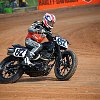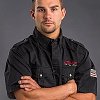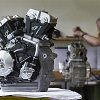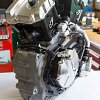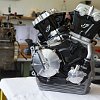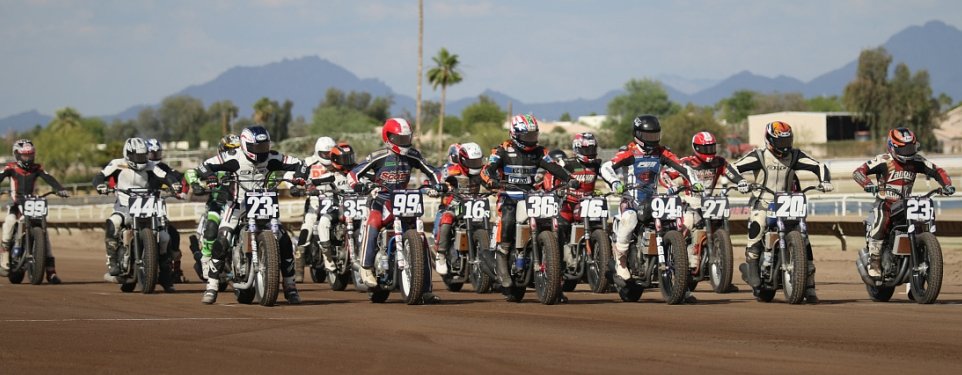A hundred years ago, Harley-Davidson and Indian staged a fierce rivalry on deadly, steep-banked board tracks. After the board track era ended, the two American icons continued their rivalry on dirt ovals. Indian won its last “National” and its last Class C championship in 1953 — then promptly went out of business (for the first time, though far from the last time.)
The Grand National Championship began the next season. In its 62-year history, Harley-Davidson riders have won 50 times.
But soon The Motor Company will take up its fabled rivalry with Indian again, because Polaris Industries recently unveiled an all-new Indian FTR750 V-twin race motor designed expressly for flat track. Current defending champion Jared Mees has signed on to develop the FTR and the company promises to race it this season. Mees will headline an Indian factory team in 2017.
Not to be outdone, Harley-Davidson’s also developing a new race motor based on the Street 750. Davis Fisher, a promising first-year Expert, was brought into the factory team to ride it (alongside former champ Brad Baker, who is still racing an XR750.)
The new Indian FTR750 and the H-D XG750R are both water-cooled, overhead-cam, four-valve V-twins, but the similarities end there. The two motors don’t even conform to the same section of the AMA Pro Racing rule book.
More to the point, Harley-Davidson and Polaris have taken altogether different routes to the same destination. I think their approaches to developing a new flat-track motor say a lot about the two companies.

Two companies, two ways to go racing
Indian built a “racing-only” motor that, under AMA Pro Racing’s rules, is limited to 750 cc. Harley-Davidson’s XG750R motor is built to AMA Pro’s “production-based” rules. If Harley had chosen to build a Street 900, they could’ve raced that. A more striking difference is that Harley hired Vance & Hines to hot rod its Street 750; Indian outsourced the development of its motor to its high-tech Swiss subsidiary, SwissAuto.
Switzerland? Yes, Switzerland
Wenko AG SwissAuto was formed in 1987 by Urs Wenger and Beat Kohler. Wenger is the chief engineer on the FTR750 project.
Racing fans with longish memories will remember hearing about SwissAuto in the 1990s, when the upstart company’s 500 cc two-strokes competed against Honda, Yamaha, and Suzuki in Grands Prix. Besides racing projects, the company’s also been a skunkworks for auto and powersports companies, including Daimler (engine development for Smart cars) and Polaris (“Wenger” four-stroke motors for snowmobiles.)
The company’s not big — a core group of a few dozen engineers, designers, and fabricators — but it punches above its weight. Polaris must’ve been impressed with those snowmobile projects, because in 2010 it bought SwissAuto’s "powersports" division, which it now calls Polaris-SwissAuto.
Flat track is the most American form of motorcycle racing (although its popularity is growing in Europe). And the limitations of grip, especially with current tire rules, mean that engines have to be designed for traction, not power. By trusting its project to Wenger and his Swiss team, Polaris bet that high-tech simulations and brainpower and GP technology could beat the decades’ worth of old-school hot rodding knowledge back here in the United States.
So far, most of what’s known about the inside of Wenger’s motor comes to us courtesy of the esteemed Kevin Cameron. He was given a peek under SwissAuto’s dirndl at the FTR750 as part of a “branded content” deal between Indian and Cycle World. According to Cameron, the motor will go from a blank CAD screen to a Grand National flat track in less than a year.
To meet that tight timetable, the Swiss team stuck with a proven layout: double overhead cams work directly on four valves per cylinder. Apparently, AMA Pro Racing “urged” Polaris to avoid the use of exotic materials, so those valves are steel, not titanium.

The valves have a narrow, 23-degree included angle, which pays dividends in combustion chamber and piston shape. The motor has a 53-degree V-angle and it’s canted slightly backward. There’s a balance shaft on each side of the crank, each of which also spins a cam chain.
In flat-track racing, a compact engine gives tuners more freedom to move the center of gravity around in the search for traction. Judging from Cycle World’s photos, Wenger did a terrific job of wrapping the crankshaft in a compact set of cases. There’s a geared primary drive to a four-speed tranny (all that’s needed in flat track) with a flat-track-ready right side shift.
You know the way Eskimos are supposed to have 50 words for snow? That’s the way flat-track racers and tuners talk about dirt. Tuners adjust flywheel weights to suit each track. Wenger set out to make that as easy as possible by having an external flywheel on the splined left side of the crankshaft. Sweet!
Again according to Cameron, SwissAuto’s target weight for the motor was 115 pounds and it’s at 106. He saw it spin to 11,400 rpm on SwissAuto’s engine dyno. Although he didn’t cite an exact power output, his story mentioned “over 100” peak horsepower at 10,000 rpm.

I spoke to AMA Hall of Fame tuner Bill Werner about the new Indian motor, and he was surprised when he read that they’d gone with a single-injector setup (as opposed to a more typical race setup, with one conventional injector in the throttle body with a second “shower” injector above the butterfly at max throttle).
Werner also questioned designing a motor without an electric starter, especially in light of AMA Pro Racing’s recent changes to the "Two-Minute Rule." There have been recent races where riders who’ve stalled on the line have missed the race altogether.

Meanwhile, back at the Harley-Davidson ranch…
Harley-Davidson entrusted the development of the Street 750 motor to James McNaughton, who is a serious racing guy. (He has since left Harley, and now works for Roush Yates Racing, where he’s in charge of Ford’s Sprint Cup motors.)
As far as Harley was concerned, they were creating an affordable street platform, but McNaughton knew that it would not cost his employers any more to engineer the Street 750’s basic dimensions — rod length, bore and stroke, and valve sizes — with future race development in mind.
Before the Street 750 even broke cover, the factory sent motors to Vance & Hines, where Matt Hines was pleasantly surprised to see McNaughton’s work.
Vance & Hines built up a few prototype bikes on Harley’s dime, which were ridden by Jared Mees, Scott Parker, and others. Then, the program was idled for a while. For whatever reason — perhaps Harley sensed Indian afoot, or maybe The Motor Company realized that if they didn’t develop a race version of the Street 750, someone else would — Harley decided to take the XG750R program to the next level.
As Matt Hines told me, “Harley asked us to see if it could really be a competitive motorcycle.”
That meant, for practical purposes, generating at least 95 horsepower at the rear wheel, in a package near the minimum weight. (Werner, who ran the Harley-Davidson race shop before semi-retirement, has done some consulting on a private Street 750 race motor project; he’s also an expert on the Kawasaki 650 motor. He says there’s no reason the XG750R can’t produce as much power as the Kawi.)
Both AMA Pro’s rules and engineering considerations suggested that Vance & Hines should swap the stock single throttle body for two 38 mm butterflies. Surprisingly, they kept the stock ECU, with the addition of a proprietary programmable Fuelpak injector management system.
That left a lot of basic hot rodding to be done. Vance & Hines rounded up the usual suspects. Competition Cams, in Memphis, has a test bench where they can spin cams at high speed, using lasers to to measure valve train performance and spot various problems in real time. For example, they can increase revs and see the exact moment that valves begin to float, or the precise rpm when rockers start to “bounce” off the nose of the cam. A custom grind was one thing, but spinning it over 11,000 rpm necessitated going to stronger double springs and titanium valves. Go figure AMA Pro’s rules, eh? The motor built under “race only” rules has steel valves, but the “production-based” motor gets Ti.)
The head begins life as a stock casting, but it’s been welded up to yield a roughly 13:1 compression ratio with better flow. CP pistons are pinned to Carillo rods. Below that, though, Matt told me the motor was almost bone stock. Vance & Hines modified the flywheel to allow them to tweak its weight. The stock Street 750’s got a six-speed tranny; the XG750R uses four of them, which allows them to remove a couple of gears and save weight. So far they’re using the stock clutch.

When I first laid eyes on the Street 750 motor, I thought it looked big and heavy, and I was skeptical about developing it as a race motor. But Matt told me that in race trim it weighs about the same as an XR750 motor.
Regardless of what I thought, the bike broke cover at Springfield this year and although Davis Fisher only made the Main by the skin of his teeth, he got a good start, picked guys off, and finished in eighth place. That’s an incredible debut in a discipline that seems simple but is actually arcane.
So far this year, the factory XG750R has dined on a few valves, but Matt says they’ve got those teething issues worked out. They’ve torn the motor down between recent races and seen no wear at all in components that would have to be swapped out in an XR750. He thinks that in the future, competitors will go several races between refreshes.
What remains to be seen?
Harley-Davidson and Indian are natural rivals, and the presence of Indian will be very good for the sport of flat track.
I think everyone can see the writing on the wall, where the XR750 is concerned; it’s in its last decade. So if we’re to see an epic Harleys-'n'-Indians battle on America’s ovals, those two companies need to turn the XG750R and the FTR750 into competitive motorcycles.


Brad Baker, who has indeed tested the XG a few times, told me that it makes decent power but that right now it’s not as tractable as his XR.
“It feels like a modern [fuel-injected] motor,” Brad told me. “It’s got a real snap off the bottom.”
That said, he didn’t rule out racing it later this season. “If their goal is to get me on the motorcycle — which it is,” he said, “I’d like to test it three days a week. The problem is, there’s not much time to do that during the season.”
I understand that AMA Pro Racing has approved the Indian FTR750 motor for use through 2019, after which time Indian will race a production-based motor.
My guess is that between now and then, AMA Pro wants Indian to make a certain number of FTR750 motors available to privateers. But how much will they cost? Right now, I’d say Indian’s got a lot more invested in each FTR750 than Harley has in each XG750R.
On paper, I like the Indian — but flat trackers don’t race on paper, they race on dirt. And perhaps more important, they race on tight budgets. Matt Hines told me that he thought a reasonable target was a cost of $10,000 for a private team to build a competitive engine. That would be much easier to do on a stock Street 750 bottom end.
Matt also told me that he thought there were five or 10 more horsepower to come out of the XG, and five to 10 pounds to come off it. The more private teams can afford to run a motor, the faster private teams will develop it.
Indian turned to a high-tech, Grand Prix-level supplier for a race-only motor. Harley-Davidson took a more cautious approach, turning a production motor over to an experienced hot rodder. Which approach will work better? Maybe it comes down to this question: Is flat track more like Grand Prix, because it’s motorcycles, or is it more like NASCAR, because it’s oval-track racing?
| Harley-Davidson and Indian engine comparison | ||
|---|---|---|
| Indian FTR750 | Harley-Davidson XG750R | |
| Displacement | 748 cc | 749 cc |
| Cylinder angle | 53 degrees | 60 degrees |
| Cam configuration | DOHC | SOHC |
| Bore x stroke | 88.0 x 61.5 mm | 85.0 x 66.0 mm |
| Valves (intake/exhaust) | 33.5/30 mm | 34.2/28.9 mm |
| Compression ratio | 14:1 | 13:1 |
| Horsepower | 109 | Approximately 95 |
| Maximum rpm | 11,400 | 11,400 |
| Weight | 106 pounds | Approximately 145 pounds |






